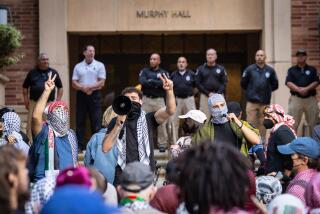Witness to 1969 UCLA shootings speaks at rally
- Share via
The quarrel between black power advocates that ended in gunfire in a UCLA classroom had lasted only a few moments that sunny day.
But the controversy over who was responsible for the murder of two young men taking part in a discussion over leadership of a fledgling black studies program at the campus has simmered for nearly four decades.
On Thursday, aging leaders of the 1960s Black Panther Party returned to the site of the Jan. 17, 1969, shooting to urge groups to work together to finally achieve equality for all.
For the first time, an eyewitness to the shootings that killed two Black Panther members -- John J. Huggins, 23, and Alprentice “Bunchy” Carter, 26 -- described publicly what happened that day in Room 1201 of Campbell Hall, on the east side of the sprawling Westwood campus.
J. Daniel Johnson is now a 60-year-old family therapist in Santa Monica. He said he was standing a few steps away from Huggins and Carter when they were gunned down by another black man, 21-year-old Claude “Chuchessa” Hubert.
“There were about 13 to 15 people in the room. But very few people witnessed what went on. . . . I saw the shooting,” Johnson told a crowd of several hundred outside Campbell Hall at a noontime rally Thursday marking the 39th anniversary of the slaying.
The shootings were followed by finger-pointing among those in various black nationalist and separatist groups that were jockeying for control of the black power movement. Johnson described the aftermath as full of “misinformation and false rumors” that needed to be dispelled.
A 21-year-old UCLA senior majoring in political science at the time, Johnson had chaired the meeting, which was called to discuss the creation “of a balanced advisory committee” and the selection of a director of the planned black studies program.
The session, held in what was then a small dining room, had ended and participants were starting to drift out when a man identified as Harold “Tuwala” Jones, 19, entered the room. Huggins confronted Jones about an encounter he’d had with another Black Panther member, Elaine Brown, Johnson said. At that point, gunman Hubert entered the fray.
“After a scuffle between John and Tuwala, Chuchessa shot John in the back. Then Bunchy tried to take cover behind a chair and Chuchessa shot through the chair and killed him instantly,” Johnson said.
Huggins, who was armed, pulled his own gun out as he fell, mortally wounded. “John emptied his gun on reflex,” Johnson said.
Later, there was speculation that there had been a gunfight. Los Angeles police arrested three members of a rival black group, US, on suspicion of conspiracy and murder. Hubert and Jones fled and were never apprehended.
Johnson said that for years he was among those who suspected that a rival black group was behind the shooting.
But “no one else deserves blame except the person who shot them,” he told the crowd. “No one else physically contributed to the death of those two besides Chuchessa.”
Johnson and others urged that Campbell Hall be renamed Carter-Huggins Hall in honor of the pair.
Brown, who lives in Brunswick, Ga., attended Thursday’s rally and voiced support for the idea.
There “was a black assassin . . . and we have to recognize the reality and not pretend and wash over the truth,” she said. “Don’t act like it didn’t happen. It happened on this campus. The blood of John and Bunchy still stains the halls of Campbell Hall.”
Huggins’ widow, Ericka Huggins, was the 20-year-old mother of an infant daughter at the time of the shooting.
Now an Oakland resident, she said various groups need to set aside their differences. “We don’t know how to talk to each other in this city,” she told the crowd at Thursday’s rally. “We can’t function like that.”
Johnson, who after the rally visited the scene of the shooting, said he still feels the U.S. government was in some way involved in the supposed escape by Hubert and Jones to Guyana, where they subsequently dropped from sight.
“Very strong forces allowed them to get out of the country,” Johnson said as he stood in the spot where Huggins fell to the floor.
He said many students were armed on campus during the tense late ‘60s. He even engaged in target practice at a campus shooting range that was operated as part of UCLA’s physical education facilities, Johnson said.
Things are more peaceful now. Many students walked by and ignored Thursday’s at-times-noisy rally.
Its organizer, Kendra Arsenault, a 20-year-old UCLA junior, said future efforts to revive the “Power to the People” rallying cry of the ‘60s will be inclusive. It will involve “black people, red people, yellow people and green people,” she promised.
--
More to Read
Sign up for Essential California
The most important California stories and recommendations in your inbox every morning.
You may occasionally receive promotional content from the Los Angeles Times.











